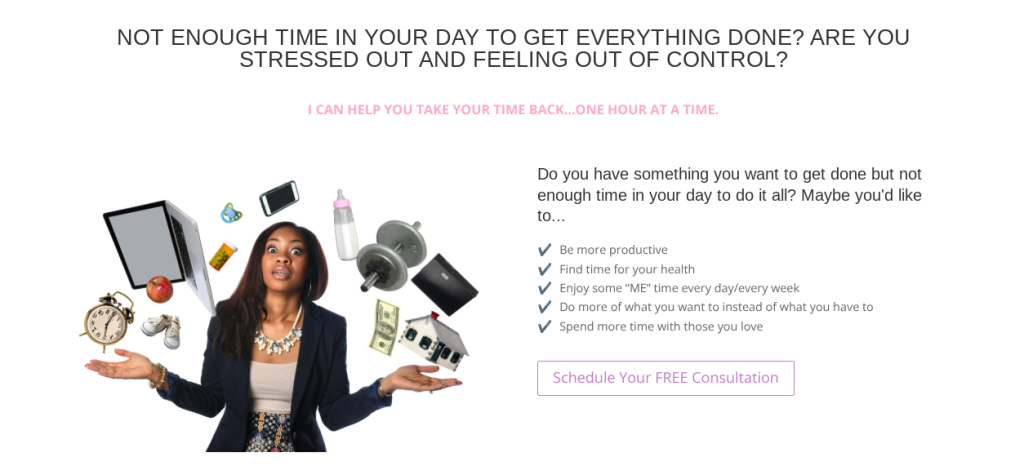I remember 2009 like it was yesterday. I was crouched on the sofa with a makeshift home office… just me, a laptop, and three curious little ones wrangling around. I had big dreams and not much else. I didn’t have it all figured out, but I had never been more driven to make something meaningful happen.
Fast forward through PTA meetings, school drop-offs, and entrepreneurship, and something shifted. I was proud of managing it all yet wondered if this exhaustion truly reflected what success was supposed to feel like. I’d come so far but still felt like I was failing to be present in my own life.
That moment of clarity marked the beginning of my self-gro1wth journey away from burnout and towards creating a life where productivity and purpose coexist, without sacrificing wellness.
Here’s how I found balance and how you can, too, using my perfected formula for success, which can add up to 100% more time to your day!

My Burnout Journey
For years, I bounced between business proposals, client calls, volunteer roles, and homework. There was always something demanding my attention. I was the person wearing “busy” like a badge, and I wore it proudly. It took a move to Florida in 2019 to create space for real reflection.
In the quiet that followed, I realized something painful. I could check all the success boxes, clients, achievements, accolades—but I was missing out on the moments that mattered most. I kept running on autopilot, checking off tasks, but it never really felt like I was alive.
That’s when burnout settled in: stuff got done, but joy and energy vanished.
What Burnout Is
Burnout extends far beyond mere exhaustion. It’s a profound emotional drain, a creeping sense of detachment, and a feeling that nothing you do truly makes a difference anymore. It manifests in subtle ways—brain fog, a loss of passion for work you once loved, and sleep that never feels rejuvenating. Yet, we tend to overlook it, wearing our fatigue as evidence of our hard work—not realizing it could be what holds us back.
Turning Point: Enough Was Enough
The pause I discovered in Florida was a gift. For the first time in what felt like forever, I could finally confront the hard questions: Was I truly here for any of it? Did any of it actually make me feel whole? I realized that hustling wasn’t the answer.
That pause led to a pivotal choice. I stepped away from endless busyness and started steering toward something different. I chose to help others blend achievement with alignment and well-being. I shifted from trying to push harder to helping people create systems that enhance their lives.
What Burnout Coaching Does
Burnout coaching isn’t magic. It’s practical, purposeful, and deeply personal. It begins with understanding your energy rhythms, values, and true priorities—not just what looks good on paper. From there, we develop habits, rituals, and boundaries that keep you moving forward without running you into the ground.
That might look like:
- Carving out focus time so you work efficiently and with purpose
- Scheduling margin to breathe—break days, buffer windows between meetings
- Learning to say no to things that drain energy, loud or small
- Prioritizing routines that reset your system: exercise, sleep, and unplugging
The goal isn’t doing more. It’s doing more of what truly matters and less of what just weighs you down.
Steps You Can Take Now
- Spot your burnout signals
Do you feel drained, cynical, like no matter what you do, it never moves the dial? That fatigue creeping in around peak moments? Awareness is the first step. - Start a time audit
Track a week of your days. Where are you spending your time? What activity energizes you? What leaves you feeling hollow afterward? - Build simple rituals
Maybe it’s spending five quiet minutes with your journal before touching your phone, or building in a reset window after meetings so your brain can breathe. Set clear, sustainable habits—not heavy expectations. - Practice saying no
Look at your commitments. Which ones support your goals? Which ones steal your time? Saying no is saying yes to yourself. - Protect your downtime
Treat your free space like a meeting. Block it out. Guard it. Use it to rest, connect, have fun, and recharge.
Real-Life Example
The client I worked with was a mother running a consulting practice. She was juggling calls, school runs, and evening volunteer meetings. She was always on, always racing through her days.
We identified her energy drains: constant context switching, no buffer between responsibilities, and days that started at 5 a.m. We built a system: focus blocks for her highest impact work, shorter workdays, dedicated evening recharge time, and personal weekends.
Within six weeks, she regained her spark. She became more present for her kids, started her evenings with intention, and stopped feeling like she was running just to run. Business was doing well—and her life felt brighter, too.
Frequently Asked Questions
What are the common symptoms of burnout?
Exhaustion, detachment from responsibilities, reduced sense of achievement, foggy focus, and feeling emotionally spent.
How long does it take to recover from burnout?
It depends on how long you’ve been running hot, the depth of your exhaustion, and how willing you are to stop rushing. Some see shifts in weeks, while others need a few months or more to build sustainable change.
What does a burnout coach do?
They help you notice what’s draining your energy and craft systems around your rhythms. They support you in setting boundaries, building consistent routines, and aligning activities to purpose.
Can burnout coaching prevent burnout?
Absolutely. Having systems that honor your well‑being means you run hard in the right direction—and pause before you hit the wall.
Who benefits from burnout coaching?
High‑achieving parents, entrepreneurs, driven professionals—anyone feeling stuck in the do‑more grind without presence or peace.
How much does coaching cost?
Packages vary. Some start in the low thousands, depending on duration and support level. Many coaches offer free discovery sessions to see if it’s a good fit.
Is burnout the same as depression?
Nobody says burnout is the same as depression. Burnout is an occupational response—and it overlaps in symptoms—but it doesn’t mean you’re clinically depressed. It does mean you’re overexposed to stress.
Are there quick strategies I can use today?
Yes. Try a 5‑minute brain dump journaling session, schedule a 20‑minute break into your next work day, and reject one thing that doesn’t serve you today.
Take Control of Your Time Today!
You don’t need to keep running like busy is a superpower. If you’re ready to move from survival mode to intentional momentum, I’d be honored to help you design a system that supports your goals and well‑being.
Let’s start with a short conversation to explore what’s holding you back and how structure can set you free. I have space for a few new clients this month—if that’s you, grab a time on my calendar or send me a message.
Let’s talk if you’re ready to create a life that energizes you, not exhausts you.
Ready to Stop Spinning Your Wheels?
You don’t need more hustle. You need a system that works for your life.
Download my free eBook, “The Productive Life Blueprint”—and start building a routine supporting your energy, goals, and peace of mind.
It’s free. It’s practical. And it’s designed for real life.
Grab your copy now and take the first step toward time freedom, which feels good.

